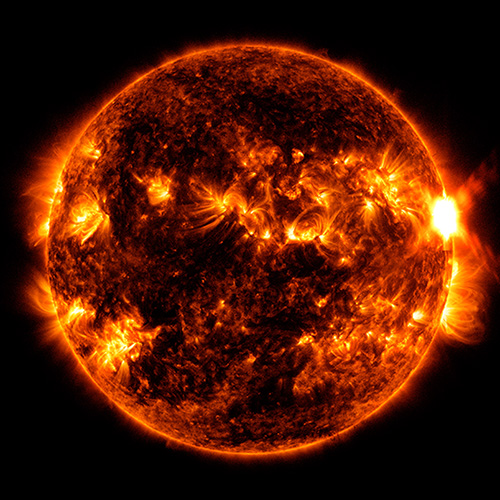
Although solar flares have been classified based on the amount of energy they emit at their peak, there has not been significant study into differentiating flares since slow-building flares were first discovered in the 1980s. Scientists have now shown that there is a significant amount of slower-type flares worthy of further investigation.
Solar flares occur when magnetic energy builds up in the Sun’s atmosphere and is released as electromagnetic radiation. Lasting anywhere from a few minutes to a few hours, flares usually reach temperatures around 10 million degrees Kelvin. Because of their intense electromagnetic energy, solar flares can cause disruptions in radio communications, Earth-orbiting satellites and even result in blackouts.
The width-to-decay ratio of a flare is the time it takes to reach maximum intensity to the time it takes to dissipate its energy.
Most commonly, flares spend more time dissipating than rising.
In a 5-minute flare, it may take 1 minute to rise and 4 minutes to dissipate for a ratio of 1:4. In slow-building flares, that ratio may be 1:1, with 2.5 minutes to rise and 2.5 minutes to dissipate.
Valluvan was a student at the Indian Institute of Technology Bombay (IITB) when this work was conducted.
Exploiting the increased capabilities of the Chandrayaan-2 solar orbiter, IITB researchers used the first three years of observed data to catalog nearly 1400 slow-rising flares — a dramatic increase over the roughly 100 that had been previously observed over the past four decades.
It was thought that solar flares were like the snap of a whip — quickly injecting energy before slowly dissipating.
Now seeing Slow-building Flares in Such High Quantities may Change that Thinking.
“There is thrilling work to be done here,” stated Valluvan who now works in UC San Diego Professor of Astronomy and Astrophysics Steven Boggs’ group. “We’ve identified two different types of flares, but there may be more. And where do the processes differ? What makes them rise and fall at different rates? This is something we need to understand.”
https://physicalsciences.ucsd.edu/media-events/articles/2024/solar-flares.html







Recent Comments